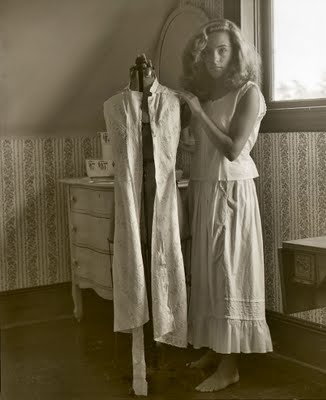Happy To Be Sad
Thursday, January 21, 2010

When I located these files of pictures I took of my two daughters in La Conner, Washington in 1988 there were several thoughts and memories that came to mind. When I saw Hilary’s pictures and noticed her blond hair with her dark eyes I immediately connected with the film Baby Doll which I had seen at about the same time as I found the La Conner negatives. In the film Carroll Baker also was blond and had dark eyebrows.
In the pictures of Ale (Alexandra) she does not smile in any of them. I have always read in her face (even in her mostly happy moments) the look of some tragedy that is within her. I think I know.
When Ale was three we had a live-in helper, Rosa, in our Mexico City home because both Rosemary and I worked all day. The details are hazy but somehow Rosa was able to locate me and she told me on the phone that Ale had drunk and emptied a bottle of Carbona (carbon tetrachloride) which she had found under the kitchen sink. In the late 60s this product was used to remove stains from upholstery.

I rushed home to find my daughter barely breathing and with her eyes closed. I opened her eyes and all I could see was the white of the eyes. I called Ale’s pediatrician who told me to induce vomiting and then wrap Ale in a warm blanket and to take her to the hospital.
Years before in Nueva Rosita, Coahuila I had been a Boy Scout. I sat down for a few minutes and tried to remember what I had learned. I had learned that certain poisons because they were corrosive should not be removed from the body in the way the doctor had indicated. I put Ale under the tap of the tub and ran cold water until she came to. Then I called Pirulí (a neighbour) who drove me around the block to a doctor who had a home practice in our area. He immediately used a stomach pump and told me that had I done as the other doctor had indicated, my daughter would not have made it to the hospital alive.
A year later Rosa and Ale went for a walk to the nearby Bebederos which was a beautiful boulevard with huge eucalyptus and a center dirt road that people from a nearby riding club used to ride their horses. Ale was enjoying the flowers that grew on the side of the boulevard and bent over to pick some. A little girl, perhaps just a bit older said, “Those are my flowers.” She picked up a piece of brick and threw it at Ale. It hit her on the forehead and she began to bleed like crazy. When Rosa arrived with Ale both were drenched in blood. I went over to the nearby doctor who told me that I need not worry as head wounds were always bloody. He then made some banderetas, a sort of little flags that he cut with scissors from a roll of adhesive tape. He used these to bring the edges of the would (a largish cut) together. Ale did not need stiches and just a little trace of the brick wound has remained to this day. At age four, Ale could not explain to me why the little girl had been so vicious.

Both Ale and Hilary were born in Mexico. Hilary (Hilarious) is a generally quite a serious person with an easy smile and a gentle disposition. Ale to this day is very Mexican. She speaks Spanish with a strong chilango (Mexico City Spanish) accent. My grandmother who did get to see Ale but was in an institution with dementia, would say of Ale, “Se le pasea el alma por el cuerpo.” (He soul goes on a trip around her body.) What this means is that Ale takes her time with things. Generally like most Mexicans she isn’t all that punctual and she loves to do things extemporaneously. She likes to drop in without calling.
Most would say she is a happy person. But discern that sadness in her face that I see in so many Mexicans. They seem to be carrying the burden of the Spanish conquest, the many dictatorships and a revolution on their shoulders. I see this sadness in the faces of little children, many, who in the poverty of Mexico never experience childhood. Is this a Mexican sadness in her face caused by a near-death experience so early in her life?

I would say that I am pleased when I see Hilary smile. It reassures me and reminds me of my mother. And in some strange way when I glance at my eldest daughter’s face and see that melancholy, I, too, wonder why a little girl would not let her pick a flower. I also see in that sadness the sadness of my father who was never a happy man. That Ale is so happy in Lillooet just shows me that some of us, including the present blogger, find happiness in being blue.






